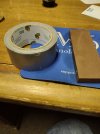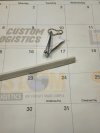r8shell
Knifemaker / Craftsman / Service Provider
- Joined
- Jan 16, 2010
- Messages
- 25,805
Clamp style sharpening systems are quite popular these days, and I can see how they could be useful for kitchen knives and other larger blades. But they aren't well suited for sharpening the small blades found on many traditional pocket knives. Besides, there's something satisfying about being able to sharpen a pocketknife freehand, using just a stone.
Here are a few tips and tricks I've discovered while learning to hand sharpen small and unusually shaped blades.
I like to use a ceramic stone, but a diamond plate or a good old Arkansas stone would be equally effective, if you prefer.
The most important technique for holding a consistant angle, is to use one or two fingertips on the spine of the blade, and gently push in an edge-leading pass across the stone. Flip the blade and move it in the other direction to sharpen the other side, still edge-leading. Another finger or your thumb can touch and slide along the side of the stone, to keep your passes straight.
Forward movement of a straight edged blade, like a sheepsfoot:

Backward movement of a slightly curved pen blade:

This method of using the left hand to guide the blade is especially useful when sharpening an x-acto blade. Removing it from its handle allows a more acute angle on the stone, but is more challenging to hold with the right hand. The right hand is simply holding the edge against the stone. The left hand is the one pushing the blade forward.

In addition to a simple flat stone, it's good to have a few small sharpening rods for touching up various blade shapes. Here, I'm using a Swiss 4 cut (very fine) round jeweler's file to sharpen the string cutter hook on a Vic MiniChamp.
Resting the back of my left hand on a flat surface is sufficient for holding the knife still, while moving the file forward.

Looking around for a few more small utility blades to sharpen, I remembered that the old fashioned style pencil sharpeners have replaceable blades. All it takes is a small phillips head screwdriver, and you can remove the blade for sharpening. It's not possible to pinch the blade with one's fingers, but it's not too hard to get the hang of holding it in flat-nosed pliers. I'm using a forward stroke, turning the blade over to do both sides.

This same technique is used to sharpen the little metal saw-toothed ripper from a tape dispenser. First I remove it from the dispenser frame and use the pliers to sharpen the full edge on a stone:

Then I snap it back into place, giving an easy way to hold it as I use the tip of a needle file on the serrations.

The next thing I planned to demonstrate was using a small ceramic rod to sharpen the curved blades of a set of nail clippers, but I think I need to stop here and go lie down for a while.
Here are a few tips and tricks I've discovered while learning to hand sharpen small and unusually shaped blades.
I like to use a ceramic stone, but a diamond plate or a good old Arkansas stone would be equally effective, if you prefer.
The most important technique for holding a consistant angle, is to use one or two fingertips on the spine of the blade, and gently push in an edge-leading pass across the stone. Flip the blade and move it in the other direction to sharpen the other side, still edge-leading. Another finger or your thumb can touch and slide along the side of the stone, to keep your passes straight.
Forward movement of a straight edged blade, like a sheepsfoot:

Backward movement of a slightly curved pen blade:

This method of using the left hand to guide the blade is especially useful when sharpening an x-acto blade. Removing it from its handle allows a more acute angle on the stone, but is more challenging to hold with the right hand. The right hand is simply holding the edge against the stone. The left hand is the one pushing the blade forward.

In addition to a simple flat stone, it's good to have a few small sharpening rods for touching up various blade shapes. Here, I'm using a Swiss 4 cut (very fine) round jeweler's file to sharpen the string cutter hook on a Vic MiniChamp.
Resting the back of my left hand on a flat surface is sufficient for holding the knife still, while moving the file forward.

Looking around for a few more small utility blades to sharpen, I remembered that the old fashioned style pencil sharpeners have replaceable blades. All it takes is a small phillips head screwdriver, and you can remove the blade for sharpening. It's not possible to pinch the blade with one's fingers, but it's not too hard to get the hang of holding it in flat-nosed pliers. I'm using a forward stroke, turning the blade over to do both sides.

This same technique is used to sharpen the little metal saw-toothed ripper from a tape dispenser. First I remove it from the dispenser frame and use the pliers to sharpen the full edge on a stone:

Then I snap it back into place, giving an easy way to hold it as I use the tip of a needle file on the serrations.

The next thing I planned to demonstrate was using a small ceramic rod to sharpen the curved blades of a set of nail clippers, but I think I need to stop here and go lie down for a while.




